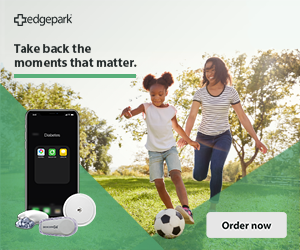FAQ: Everything you need to know to get started with CGM therapy
If you're considering continuous glucose monitoring therapy — or CGM therapy — to help manage your type 1 diabetes (t1d), you may need more information before making any changes to your routine. We've gathered answers to the most frequently asked questions about CGM devices, so let's dive in!
1. What is a continuous glucose monitor (CGM), and what does it do?
A CGM is a medical device that tracks blood glucose levels throughout the day at fixed intervals, providing alerts when measurements cross high and low thresholds. It can also be used to analyze data trends, impacting diabetes management both in the moment and over longer periods of time. The sensor data can provide insights to your medical team that are not available based on quarterly lab draws and blood glucose logs alone.
2. What are the benefits of using a CGM device?
There are many benefits of using CGM, including safety alerts, directional trend arrows — which can help inform diabetes management decision-making — improved quality of life from tighter control due to more awareness of trends and fluctuations, and the ability to utilize CGM data as part of automated insulin delivery systems. CGMs that have received approval from the FDA for use in making treatment decisions can also help reduce the number of fingerstick blood sugar checks that a person with diabetes would otherwise need to do throughout the day and night.
3. Is a CGM device right for me?
While there are studies that have documented the long-term benefits of using CGM for people living with t1d, it's hard to say if any one way of managing diabetes is right for everyone. There can be a period of adjustment and a learning curve for people who are new to CGM, whether they're newly diagnosed or have decades of experience.
4. How does CGM technology tie in with insulin pumps?
The importance of accuracy in CGM data has never been more vital due to increased reliance upon sensor values for decision-making. Closed-loop and hybrid closed-loop insulin delivery systems require a CGM and insulin pump to work. The pump has the ability to make adjustments to insulin delivery based on sensor data.
5. What are the CGM manufacturers?
There are currently four manufacturers distributing CGM products in the U.S. at this time. Here are some highlights of the current models. You should consult with your doctor to learn more about how each one works and to determine which is the right fit for your lifestyle.
The newest model from Abbott provides real-time alerts and a 14-day sensor wear
The LibreLink app provides the ability to share your data with up to 20 people
The Dexcom G6 CGM can be used standalone or as part of Tandem's closed-loop pump, the t:slim X2 with Control-IQ
The sensor can be worn for 10 days, and data can be shared with up to 10 followers on the Dexcom Follow phone app
Medtronic MiniMed Guardian™ Connect
The Guardian 3 sensor is part of the 770G closed-loop system, 670G closed-loop system, and 630G hybrid closed-loop system, while the Guardian Connect is a standalone CGM
Both applications of Medtronic CGM technology utilize a seven-day wear; the CareLink Connect app allows data sharing with up to five people
The Eversense CGM implantable sensor has a duration of 90 days of use
CGM data can be shared with up to five people through the Eversense NOW app
- A trained healthcare provider must perform the outpatient sensor implant procedure; if interested in this CGM, you will want to ask your doctor if they're able to do the insertion for you
6. How much does a CGM device cost?
The cost of CGM therapy can vary greatly due to insurance coverage. Call your member services representative for the details on what your plan covers. If you access CGM through a durable medical equipment (DME) benefit, you'll likely have coinsurance, whereas accessing CGM supplies through pharmacy benefits means you'll be responsible for a co-pay. All of this is subject to meeting your deductible if you have one. If you're not insured, speak directly with your physician and the CGM manufacturer to see what options may be available to you.
7. How do you obtain a CGM device?
CGM requires an active prescription from your doctor, so discuss your interest in starting CGM therapy at your next appointment. You'll also need to know where to have the prescription sent, so find out whether your insurance company requires you to order directly from the manufacturer, a diabetes supplier like Edgepark, or your pharmacy.
8. Are CGM devices covered by insurance?
Insurance coverage for CGM is more common for people living with t1d than it has been in the past. Coverage is now fairly widespread for people living with t1d and many folks with type 2 diabetes (t2d) are finding success in getting coverage for these devices as well. Some plans may require additional information from you and your medical team in order to get approval for coverage. As with any healthcare process involving paperwork and multiple parties working together towards a positive end result, it may take some time to get started on CGM or receive supplies. Planning ahead wherever possible can help streamline your coverage and access.
9. How do you order a CGM device through Edgepark?
The process of ordering your CGM device through Edgepark is simple. Once you place an order, Edgepark takes care of the rest- verifying coverage, collecting required medical documentation, and shipping the order right to your doorstep. Once you've begun CGM therapy, be sure to create an account and check out the Reorder Reminder program to stay on top of reordering your supplies.
Is CGM therapy right for you?
It could be! Hopefully exploring the answers to these frequently asked questions about CGM has helped you determine whether it might be a useful addition to your t1d management. If you're still undecided, consult your doctor about the pros and cons of CGM usage specific to you.
If you're new to CGM therapy, you may still need more information. Learn about the basics of getting started with CGM on the Health Insights diabetes blog.




